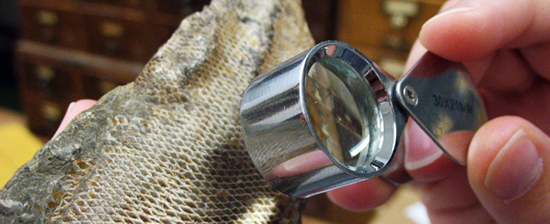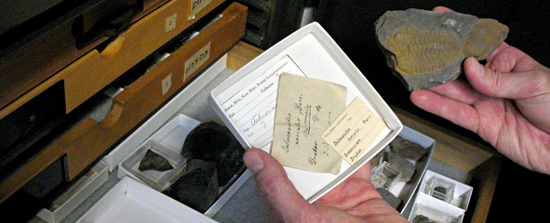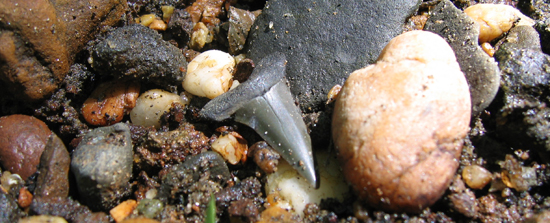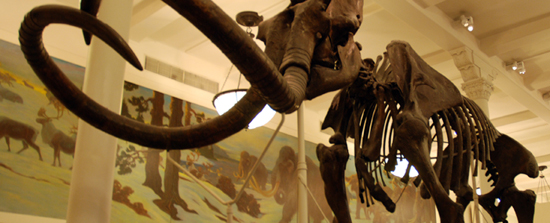Paleontology FAQ
- What is a fossil?
- Is this a fossil egg?
- How much is this fossil worth?
- Does the Division of Paleontology accept donations of fossil material?
- How do I become a paleontologist?
- How do I get a job in the Division of Paleontology?
- How do I become a volunteer in the Division of Paleontology?
- Where do I find fossils?
- Does the Museum sponsor any fossil collecting trips?
- Where does Division of Paleontology dig for fossils?
- What kind of research is done in the Division of Paleontology?
- How are the fossil halls arranged?
- Is what's on display everything you have?
- What's the oldest fossil in the American Museum of Natural History?
- What is the Division of Paleontology's connection with artists?

What is a fossil?
A fossil is any evidence of life from a previous geologic age (i.e., older than 10,000 years). Most fossils are mineralized, or "turned to stone," but this need not have occurred for an object to be a fossil. Insects in amber, Pleistocene mammoths frozen in permafrost, and even 80 million year old wood that one can light with a match are all fossils that remain very much like the original organismal remains. Fossils also include traces of the activity of organisms in the form of footprints, tooth marks, trails, burrows, and coprolites, or fossil feces. The fossil record is dominated by the hard parts of living things — bones, shells, wood, etc. — because they resist decay, but if conditions are right, almost anything can be preserved. Fossils of vertebrate internal organs and skin, jellyfish, and even the "flatulence" of protozoans actually exist.
Is this a fossil egg?
Nature has many ways to create rounded rocks that resemble eggs - their resemblance is merely accidental. River-rounded rocks are commonly mistaken for fossil eggs. Sedimentary concretions are another common imposter. Concretions often form when some object acts as a "seed" for the deposition and cementation of sequential layers of sediment. On occasion, the thing that initiates the concretion, the "seed" can be a fossil. To find this out would require cracking open the concretion.
Genuine fossil eggs usually have an easily identifiable shell which differs significantly from the enclosed sediments either by having a fine surface ornamentation (the smoother the "shell," the less likely it is to be a non-bird dinosaur egg) or a specific type of crystalline structure in cross-section. Also, because eggshell tends to be brittle, the shell is almost always heavily cracked with clear shifting of the eggshell bits. Ironically, one strong indication against a dinosaur egg identification is a very egg-shaped specimen: most fossil eggs are not "egg-shaped" because most fossil eggs come from non-avian dinosaurs and are everything from spherical to torpedo-shaped.
Additionally, the thickness of the "shell" can rule out an egg ID. Embryos in hard-shelled terrestrial eggs need shells through which they can conduct gas exchange — basically so they can breathe. Past a certain thickness, this becomes impossible.
How much is this fossil worth?
The Division of Paleontology is more than happy to identify fossils but we don't do appraisals. The value of a fossil is often in the eye of the beholder.
Does the Division of Paleontology accept donations of fossil material?
With a collection as large and as comprehensive as ours, and because of very limited space, we have to be very choosy about any material offered to us. Any fossils that we might consider accepting must of course be relevant to our collections. This could be because it fills a gap in what we have in our collections or what the science of paleontology currently knows. We are very unlikely to accept a fossil specimen of a type for which we already have scores of examples. Additionally, but even more importantly, any specimens we consider accepting must have documentation showing two things: legality and locality. It must be shown that a specimen was legally acquired by the person offering it and it must have information describing precisely where it was found. Without this latter information, little, if any, worthy science can be conducted on the specimen.

How do I become a paleontologist?
There are many jobs that exist within the field of paleontology. Academic jobs require rigorous college or university training. Collections managers (the "librarians" of fossil collections) and fossil preparators (those who mainly remove rock from fossils to reveal their details) arrive at their jobs in various ways. Some have training as artists or librarians, or undergraduate backgrounds in biology. Volunteering at a museum or other institution that works with fossils is another good way. One will learn about the often-invisible variety of jobs within the discipline and can also acquire skills for certain behind-the-scenes jobs that are rarely if ever offered in academic institutions.
How do I get a job in the Division of Paleontology?
The best place to look is on the Museum's Job Postings Page.
How do I become a volunteer in the Division of Paleontology?
The best place to look is on the Volunteers Page.

Where do I find fossils?
The best way to learn what fossils may be legally collected in your area is to get involved with a local fossil club or society. These groups very often conduct local field trips which are a great way to learn from others what fossils are to be found and also how to collect them. Additionally, they often offer lectures on a variety of topics related to paleontology and, thus, can be informative learning opportunities. The Web is also a good place to zero in on places to collect fossils.
Does the Museum sponsor any fossil collecting trips?
Several trips a year are organized by the Membership department for AMNH members. Trips to collect Devonian fossils in Pennsylvania and Late Cretaceous marine fossils and amber have been popular trips in the recent past. Learn more about Museum membership. One benefit is Rotunda, a newsletter that lists all events available to members.
Where does Division of Paleontology dig for fossils?
Since 1990, the Division has been conducting paleontological expeditions in Mongolia's Gobi Desert reprising historical work initiated by the American Museum in the 1920s. An amazing assortment of abundant fossil birds and other dinosaurs, lizards, and mammals have kept and will keep, AMNH scientists and their colleagues busy for decades. Our paleontologists are also active in the Andes collecting Eocene mammals; across the US (South Dakota, Wyoming, Montana, Colorado, and Missouri as well as closer to home in New Jersey) looking for Late Cretaceous ammonites, as well as farther abroad in the Bay of Biscay in southwestern France, Denmark, and Japan; in Madagascar finding Late Triassic mammals and dinosaurs; in Alaska looking for Devonian sharks with sights on future fossil fish finding in Bolivia, Australia, and the mid-West US; in China unearthing dinosaurs from across the entire Cretaceous; and in New Mexico pushing back the origins of dinosaurs. With a world full of fossils, we will certainly be adding new localities to this list as we have for our entire fossil hunting history.
What kind of research is done in the Division of Paleontology?
The majority of paleontologists in the Division do research on phylogenetic systematics, or figuring out where and how each animal fits into the tree of life. Our Division has been a lead figure in this field for decades and specializes in the use of a technique called cladistics to discern phylogenies. These phylogenies help illuminate the origins and evolution of extinct as well as extant groups.
But the Division makes use of its immense and comprehensive fossil collections in many other ways as well, taking full advantage of state-of-the-art laboratory methods like high-resolution surface and CT scanning, scanning electron microscopy, digital imaging, radiography, and even DNA sequences of sub-fossil and modern organisms. These include using plate tectonics, biogeography, and paleomagnetism to improve our reading of the age of rocks and fossils, and investigating global extinctions of the geologic past to understand the present-day biodiversity crisis. Division studies cover everything from ontogenetic development (the course an organism takes from conception to adulthood) to the general relationship between extinction and evolution. Division curators also delve into the theoretical, such as developing methodologies for evaluating the effect of missing data on large data sets or for deciding the relative importance of different organismal characteristics in uncovering their phylogenies, using phylogeny to estimate patterns in the fossil record such as diversity and extinction, and assessing the relationship between a fossil's position in the rock layers and its place in the Tree of Life.
The Division of Paleontology also houses an extensive archive of correspondence, field journals, maps, illustrations, and administrative paperwork associated with the Department of Vertebrate Paleontology (archival materials relating to invertebrate paleontology are housed with the archives of the Division of Invertebrates, with which the Department of Invertebrate Paleontology was formerly associated) used by historians of paleontology and other researchers.
The Paleontology Collections and Vertebrate Paleontology Archives are generally open to bona fide academic researchers who are affiliated to a recognized academic institution. Approval by the AMNH staff is required.

How are the fossil halls arranged?
The redesigning of our Fossil Halls in the 1990s gave us an opportunity to start from scratch with respect to telling the story of vertebrate history. Traditionally, large exhibits of fossils have been arranged as a "walk through time," keeping pace with the flow of time and the changing suite of animals that lived together at intervals in Earth's history. As a leading institution of phylogenetic systematics, or figuring out where and how each animal fits into the tree of life, we decided to feature this perspective in our exhibits. As one walks through the Fossil Halls, one traces ancestries along the trunk and branches of the Tree of Life. Closely-related animals are featured together rather than animals close in time or space.
Is what's on display everything you have?
There are close to 800 fossil specimens currently on display, but our scientific collections hold over 400,000 fossil mammals, over 30,000 fossil amphibians, reptiles and birds, more than 17,000 fossil fish, and approximately 4.25 million fossil invertebrates. The overwhelming majority of our, and in fact of most, natural history collections are preserved primarily for research rather than display, and visitors from around the world use our collections every day to advance science. Due to the limitations of display space, the exhibitability of specific specimens, and the redundancy of certain specimen varieties, only a tiny percentage of what we have is on exhibit.
What's the oldest fossil in the American Museum of Natural History?
On display is not only our oldest fossil, but one of the oldest fossils yet known on Earth. In the Hayden Planetarium's Cosmic Pathway, you can see a stromatolite from the Warrawoona Group of Western Australia that is 3.45 billion years old. Stromatolites are structures built by single-celled bacteria and the Warrawoona specimen comes from a time when life was exclusively bacterial.
What is the Division of Paleontology's connection with artists?
Arguably, one of the most effective way of teaching paleontology and engendering interest in it is to restore them as living creatures. The Division has proudly employed restorations of extinct organisms as part of its fossil displays throughout its history. Charles R. Knight, regarded by many as the grandfather of paleoart, produced an impressive amount of iconic paleorestoration for the AMNH in the early years of his career in the form of paintings and sculptures. This tradition continues today with Division artists like Mick Ellison who specializes in fossil dinosaurs and mammals and Frank Ippolito who focuses on fossil turtles and dinosaurs. Scientific photography and illustration are another strong point among Division artists with Lorraine Meeker and Chester Tarka who work with fossil fish and fossil mammals and Stephen Thurston who works with fossil invertebrates rounding out the work Mick and Frank do with fossil reptiles. Our Division artists also work closely with an array of artists in the AMNH's Exhibition Department, who often create traveling exhibits that include 3D life restorations of extinct organisms.